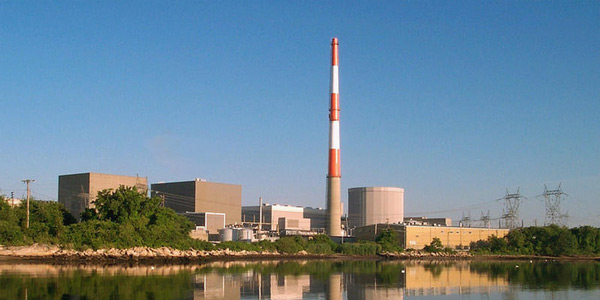By Michael Kuser
The Millstone nuclear power plant will bid into ISO-NE’s 12th Forward Capacity Auction next year, indicating owner Dominion Energy expects it to continue operations into at least 2022.
Despite questions about Millstone’s profitability, Dominion did not inform ISO-NE by the March 24 deadline of its intent to retire the plant. Assuming Millstone clears the auction, it would be obligated to operate through May 2022, the end of the 2021/22 planning year.
Dominion’s decision has implications both for New England’s wholesale market — the plant’s delisting would have created upward pressure on capacity prices — and the company’s hope for support from Connecticut lawmakers.
In March, Connecticut legislators unveiled a bill that would allow Millstone, the state’s only nuclear generator, to bid into the state procurement process now reserved for renewable energy resources. (See Connecticut Moves Closer to Equating Nuclear with Renewables.)
Matt Fossen, spokesman for the Stop the Millstone Payout coalition, said Dominion’s failure to file a delist bid by the March 24 deadline undermines the claims of Dominion lobbyists who “make it sound like there is a dire, impending threat to the plant’s existence.” This could not be true, he said, if the plant can continue operating for the next five years.
“Dominion will always meet its obligations in the markets in which we operate, but we do have the ability, within the current market rules, to cease operations if a facility is no longer economically viable,” responded Kevin Hennessy, Dominion’s state policy director for New England. “The dirty fossil fuel generators who oppose CT Senate Bill 106 are threatened by the state smartly choosing to purchase power from clean, reliable, carbon-free sources of electricity like Millstone. Connecticut consumers pay the highest retail electric rates in the country. SB 106 would reduce those rates by cutting out the middle man and allowing the state to buy directly from Millstone.”
ISO-NE spokesman Matt Kakley wanted no part of the dispute. “As the administrator of the region’s competitive markets, the ISO does not comment on the business decisions of individual market participants,” he said.
Is Millstone Profitable or Not?
Hennessy said Dominion does not release profits or loss data on individual units. But in its earnings call for the fourth quarter of 2016, CFO Mark F. McGettrick indicated Millstone, which will have two refueling outages this year, would be a drag on earnings and that it will be “challenging” for the company to meet its historical earnings growth rate. “Now that we have hedged most of Millstone’s 2017 expected output, we estimate a $10 to $12/MWh reduction in realized energy prices versus last year, impacting 2017 earnings by about 15 to 20 cents/share,” he said, according to a transcript by Seeking Alpha.
The company, which had operating earnings of $3.80/share in 2016, is projecting $3.40 to $3.90/share for this year.
However, in projecting operating earnings for 2018, McGettrick said that the Connecticut nuclear power station would likely contribute to earnings, as only “one fuel refueling outage at Millstone should add another 10 cents/share to year-over-year results.”
The company said the net capacity factor for its six units was 93% last year, the highest since 2013 and the second highest since Millstone was acquired in 2001 from Northeast Utilities for $1.28 billion.
Greg Gordon, head of power and utilities research at investment advisory firm Evercore ISI, asked officials on the call to confirm whether Dominion “did not contemplate any change in regulatory scheme in Connecticut or Massachusetts, as it pertains to clean energy credits for Millstone.”
McGettrick responded that the “only thing we’ve factored into our growth rate and for 2018 is a very modest increase in power prices in the Northeast just because we think they’re extraordinarily low right now. It was not a reflection of any legislative effort that would be out there, but just … a normal slow recovery in the Northeast on power.”
Michael Weinstein, a broker at Credit Suisse Securities, asked about the possibility for Massachusetts legislation to support nuclear and what form it might take.
CEO Thomas F. Farrell said, “What we’ve heard is more through the regulatory process in Massachusetts, but yes … all of this is in development. … It would be a similar approach to what Connecticut is considering. … It is an opportunity for us to fit into their clean energy program and compete with other clean energy sources.”
Angie Storozynski, an analyst for Macquarie Capital, asked how much the Connecticut legislation and other state efforts supporting nuclear would add to earnings. “Are we talking, I don’t know, 5 cents, are we talking 20 cents? I mean, just a rough estimate.”
“We have no estimate to give you,” McGettrick responded. “The legislation is not even out of committee. And the exact structure is still evolving, I think, so we don’t have any estimate or even a probability at this point whether there’ll be success in Connecticut. We would hope there would be, but we don’t have a number today at all.”
At 2,111 MW, Millstone is New England’s largest power plant, producing more than half of the electric power used in Connecticut and about one-seventh of New England’s. Unit 2 (883 MW) is licensed to operate through 2035, while Unit 3 (1,228 MW) is licensed through 2040.



